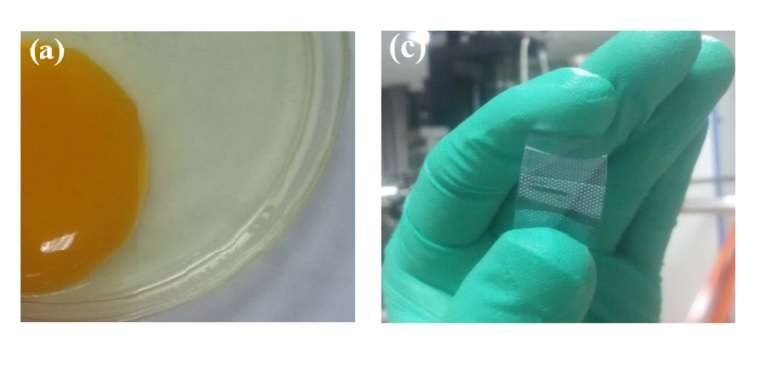September 28, 2017 feature
'Egg-based electronics' offer surprisingly good electrical performance

(Phys.org)—Egg white—also known as egg albumen—is not only good-tasting, it also has very good dielectric properties, along with a high transparency and high elasticity, that make it a promising material for fabricating transparent, flexible electronic devices. In a new study, researchers have shown that, when egg albumen is mixed with hydrogen peroxide, a series of chemical reactions occurs that transforms the biomaterial into an active film that can be used to make transparent, flexible resistive memory devices.
The researchers, led by Qunliang Song at Southwest University, China, have published a paper on using hydrogen-peroxide-modified egg albumen for resistive switching memory in a recent issue of Nanotechnology.
"As a promising alternative to the conventional silicon-based nonvolatile memory, the egg albumen has more advantages than other materials," Song told Phys.org. "The bio-organic material egg albumen may have potential applications in the imitation of biological memory behavior, artificial intelligence, and brain-like intelligence because of the good compatibility."
This is not the first time that egg albumen has been incorporated into electronic devices. Previously, the albumen from chicken and duck eggs has been used in transistors and other devices as the dielectric (insulating) layer.
However, the new work marks the first time that egg albumen has been used to make resistive memories. These memories are being developed as a next-generation alternative to the silicon-based memories that dominate today's electronics. Resistive memories, which operate based on changes in resistance rather than electric current, have potential advantages such as higher speeds, higher densities, and smaller sizes.
One of the main components of resistive memories is a dielectric film—here, the egg albumen-based film—which is normally insulating but can be made conducting by applying a voltage. Switching between these states of high and low electrical resistance corresponds to switching between the memory's "off" and "on" states, respectively.
The researchers demonstrated that the resistance of egg albumen material can be made switchable by mixing it with a 10% hydrogen peroxide solution. Egg albumen contains more than 40 different proteins that are linked together by weak chemical bonds. Deep inside these proteins are large numbers of iron, sodium, and potassium ions. The hydrogen peroxide easily breaks the bonds holding the proteins together, which denatures the proteins and, critically, exposes the ions.
These ions, which are positively charged, then act as traps that capture negatively charged electrons that are injected when a voltage is applied. When the trap levels are low (few or no electrons), the dielectric material behaves as an insulator and the memory is in the "off" state. When a negative voltage is applied, it causes the traps to fill with electrons, the material becomes conducting, and the memory switches to its "on" state. To reset the memory, a positive voltage is applied, releasing the electrons from the traps and returning the memory to its "off" state.
"Ions such as Fe3+, Na+ and K+ are always connected with protein chains in the chicken egg albumen, and so cannot work efficiently when charges are injected," Song said. "Treated with 10% hydrogen peroxide solution, the ions can be exposed outside of the protein chains and act as the traps to capture the injected charges. Thus the resistive switching memory properties of the hydrogen peroxide-modified egg albumen film was efficiently improved compared to those of pristine egg albumen."
Overall, the researchers demonstrated that the egg-albumen-based resistive memory compares favorably to other memories, exhibiting a high on/off resistance ratio, as well as good retention and switching endurance even after repeated bending.
"Although great progress and breakthroughs have been made regarding the new material's application and structure design, the mechanism of resistive switching memory is still not completely clear," Song said. "We will continue our investigation of the mechanism of resistive switching memory. At the same time, flexible, wearable and water-dissolution resistive switching memory cells will be developed using organic-modified egg albumen in our following work."
More information: Guangdong Zhou et al. "Hydrogen-peroxide-modified egg albumen for transparent and flexible resistive switching memory." Nanotechnology. DOI: 10.1088/1361-6528/aa8397
Journal information: Nanotechnology
© 2017 Phys.org



















